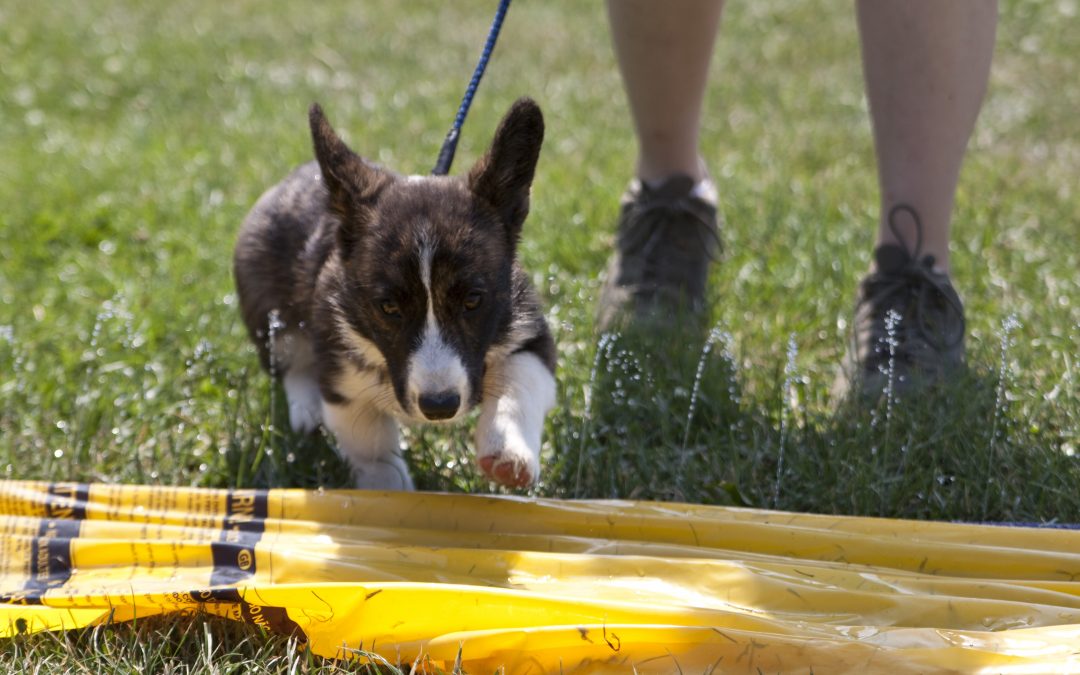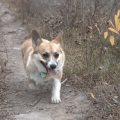Table of Contents
These dogs love to run around, nip, bark and pretty much do various kinds of activities that test their corgi agility. While most corgis don’t herd cattle anymore, they do love learning, and doing some kind of task where they can work independently and apply their natural herding instinct. Many corgis enjoy agility training because it requires both brain and muscle power. In this article, you’ll learn about corgi agility and some training activities for them.
Pembroke Welsh Corgi vs. Cardigan Welsh Corgi
Welsh Corgis are clever, active, and playful dog. It has two types: the famous Pembroke Welsh Corgi, and the Cardigan Welsh Corgi.
The Cardigan Welsh Corgi is a dog that sports a long body which almost touches the ground. It also has quite a flat skull with a head that’s more proportional to its body rather than its small legs. It also sports wide eyes with a dark rim at its edges that add depth to it.
It has a black nose and a muzzle that’s parallel to its skull. Almost all Cardigan Welsh Corgis have brown eyes. Their ears are black and large but in proportion to their skull. The legs of this particular dog breed are short with its front feet bending outwards. The breastbone is very prominent and deep.
Just like the Cardigan Welsh Corgi, the Pembroke Welsh Corgi is a long dog with short legs. The major difference is that the latter is not that heavily boned than its counterpart. It has a more fox – like appearance and also a much shorter tail. In fact, Pembroke Welsh Corgis have been compared to foxes a lot because of their stocky frame, pointy long ears and their long muzzles. The Pembroke Welsh Corgi also don’t sport a long tail, and in a few instances, a very short one. There are keepers who tend to dock the dog’s short tail, which is illegal in some states.
Corgi Agility: Herding Instincts
For as long as history can remember, the one job that makes any dog breed the happiest is when he has been working alongside his master or companion. However, if you have a dog like the Corgi, who is looking for a career rather than just a job, herding is the way to go. This traditional career puts the corgi agility dog to work by controlling the movement of a herd of animals, specifically the cattle, that’s out to pasture, or back to the barn at night.
While you can train other canine to herd animals, the Welsh Corgi breed are one of the best at this kind of task because overtime, they have developed a strong and natural instinct to herd. The most important thing to keep in mind is that the dog you choose for your next herding class needs to have the required intelligence, corgi agility, and drive in order to become a successful herding dog.
Corgi Agility: Training
Puppy training is great as it can hone your pet’s natural herding instinct and also enhances it which allows you to make the dog listen to your commands. One thing that will make training your corgi agility more successful, is to make sure he has mastered all four of the basic commands, including ‘come’, ‘sit’, ‘stay’, and ‘down’. This establishes your role as the leader or master in your pup’s pack and ensures that he takes his direction from you.
You will essential be training your puppy to work with you, and if you have a stock, then he/ she can really be of help in moving the animals around your farm or ranch. There is nothing quite like watching your corgi agility dog makes the change from a bundle of puppy energy into a mature dog standing at attention, and waggling in anticipation as he awaits your command. At all times during the training process and afterward, make sure to keep an eye on your Corgi pup to keep him out of places where he could be hurt.
A herding dog’s best years tend to be between the ages of 4 and 8, but the sooner you start training your pup to work with livestock the better. It will also help him develop his natural herding skills through interacting with the animals in your herd or flock.
You actually don’t need to wait until your Corgi pup is old enough to be able to have the physical strength, the stamina, and the cognitive ability to handle the challenges of the training and the job. Typically, this happens around the 10 to 12 – month point. If you seem to be having difficulty training your pet, then you just need to wait a few months until he is more amenable to the training and improving its corgi agility.
Corgi Agility: Health Problems
In matters of health and corgi agility, just like any other dog breed, they are prone to acquiring some diseases or infections. However, this doesn’t mean that your dog will eventually suffer any of these specific infections. It only means that the chances might be higher for Corgis to get infected with these diseases than for any other breed.
However, prevention is better and with the right treatment they will surely recover quickly. Therefore, it is highly recommended to keep your Corgi always vaccinated against the diseases as they are exposed due to their genetic makeup as well as other factors. Note that vaccination is not a guarantee that your pet might not get ill.
Obesity is a very common problem affecting Corgis in these modern times. They have a large appetite and if you don’t make sure that they follow a strict control on their diet, they could easily gain excessive weight.
They also require intense physical corgi agility exercises each day. As you know, obesity leads to many other complications including joint pain, arthritis and in rare cases, even sudden death.
Other health problems which have been encountered are eye disorders, Von Williebrand disease and Degenerative myelopathy. These conditions can be avoided if the breeder selectively choose healthy parents before breeding them. Make sure to monitor your Corgis’ agility and weight closely to determine when there is a problem and take early remedial measure.






 Author and long-time animal lover. Sharing knowledge on pet care through experience and the written word.
Author and long-time animal lover. Sharing knowledge on pet care through experience and the written word.